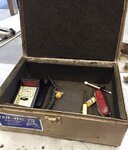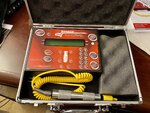- 6,394
- 8,275
HOME / NEWS / HIGH BANKED OVAL ROAD COURSE RECOMMENDATIONS
High Banked Oval Road Course Recommendations

Hoosier Tire’s circuit racing tire line is designed for flat road course applications throughout the country. However, as several sanctioning bodies include high banked oval road courses in their race schedules, Hoosier Tire customers must take note on the car and tire setup differences when running on these high banked oval road courses. These recommendations must be adhered to or tire overloading will occur. High banked oval road courses include, but are not limited to, Daytona International Speedway, Texas World Speedway, Las Vegas Motor Speedway, Auto Club -Fontana Speedway, Homestead – Miami, Lowes Motor Speedway, Kansas Speedway, New Hampshire Int’l Speedway, Pikes Peak International Raceway, Pocono Raceway, Texas Motor Speedway and Watkins Glen Int’l. Although Watkins Glen Int’l is not a high banked oval road course, it does offer high speeds and loads similar to high banked oval road courses. Cold starting pressures also need to increase even further when an aero package used. This will produce additional down force and can damage race tires if air pressure is not increased.
GT1 16” Slicks – R70A
Air Pressure: (Cold) 22 – 23 psi (Hot) 30 – 32 psi+
Camber Settings: Front: -2.0 degrees or less Rear: -2.0 degrees or less
GT PRO Slicks – S, MS, M
13” – 16” Wheels
Air Pressure: (Cold) 22 – 24 psi (Hot) 28 – 30 psi+
Camber Settings: Front: -2.0 degrees or less Rear: -2.0 degrees or less
18” Wheels
Air Pressure: (Cold) 26 – 28 psi (Hot) 34 – 36 psi+
Camber Settings: Front: -2.0 degrees or less Rear: -2.0 degrees or less
DOT – R7 / A7
Air Pressure: (Cold) 30 – 32 psi (Hot) 40 – 42 psi+
Camber Settings: Front: -2.0 degrees or less Rear: -2.0 degrees or less
Historic Stock Car – R75A
Air Pressure: (Cold) 23 – 25 psi (Hot) 30 – 32 psi+
Camber Settings: Front: -2.0 degrees or less Rear: -2.0 degrees or less
Please contact us before utilizing any Hoosier Tire not listed above at the tracks listed. Being diligent in monitoring air pressure and your tire temperatures throughout your sessions at high banked oval road courses, this is key for our tires to work properly. If you have any more questions about these recommendations, do call Hoosier Racing Tire at 574-784-3152.
High Banked Oval Road Course Recommendations

Hoosier Tire’s circuit racing tire line is designed for flat road course applications throughout the country. However, as several sanctioning bodies include high banked oval road courses in their race schedules, Hoosier Tire customers must take note on the car and tire setup differences when running on these high banked oval road courses. These recommendations must be adhered to or tire overloading will occur. High banked oval road courses include, but are not limited to, Daytona International Speedway, Texas World Speedway, Las Vegas Motor Speedway, Auto Club -Fontana Speedway, Homestead – Miami, Lowes Motor Speedway, Kansas Speedway, New Hampshire Int’l Speedway, Pikes Peak International Raceway, Pocono Raceway, Texas Motor Speedway and Watkins Glen Int’l. Although Watkins Glen Int’l is not a high banked oval road course, it does offer high speeds and loads similar to high banked oval road courses. Cold starting pressures also need to increase even further when an aero package used. This will produce additional down force and can damage race tires if air pressure is not increased.
GT1 16” Slicks – R70A
Air Pressure: (Cold) 22 – 23 psi (Hot) 30 – 32 psi+
Camber Settings: Front: -2.0 degrees or less Rear: -2.0 degrees or less
GT PRO Slicks – S, MS, M
13” – 16” Wheels
Air Pressure: (Cold) 22 – 24 psi (Hot) 28 – 30 psi+
Camber Settings: Front: -2.0 degrees or less Rear: -2.0 degrees or less
18” Wheels
Air Pressure: (Cold) 26 – 28 psi (Hot) 34 – 36 psi+
Camber Settings: Front: -2.0 degrees or less Rear: -2.0 degrees or less
DOT – R7 / A7
Air Pressure: (Cold) 30 – 32 psi (Hot) 40 – 42 psi+
Camber Settings: Front: -2.0 degrees or less Rear: -2.0 degrees or less
Historic Stock Car – R75A
Air Pressure: (Cold) 23 – 25 psi (Hot) 30 – 32 psi+
Camber Settings: Front: -2.0 degrees or less Rear: -2.0 degrees or less
Please contact us before utilizing any Hoosier Tire not listed above at the tracks listed. Being diligent in monitoring air pressure and your tire temperatures throughout your sessions at high banked oval road courses, this is key for our tires to work properly. If you have any more questions about these recommendations, do call Hoosier Racing Tire at 574-784-3152.















